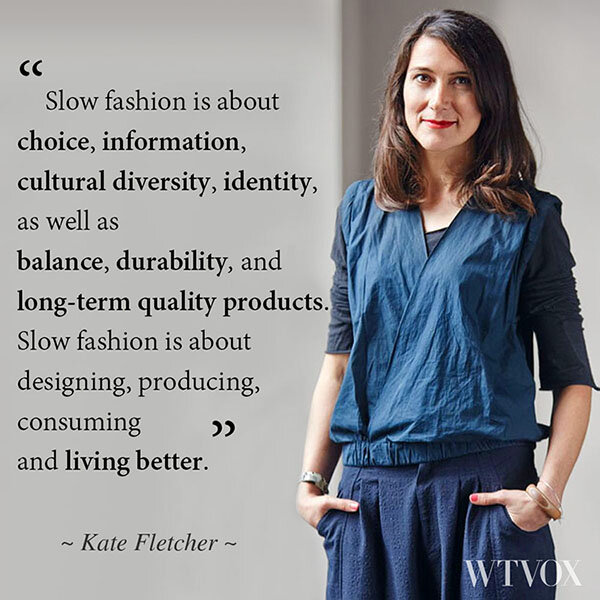A Brief History in Sustainable Fashion Milestones
There is no doubt that 2020 has been challenging for us all. Loved ones are lost. Many are struggling to get by. Despite such a difficult year, humanity’s resourcefulness and resilience shone through, bringing advances on multiple fronts.
General awareness of our environment and its vulnerability has spread throughout the years, making us question our decisions, and brands are listening. Still, this is not meant to lessen or distract you from the harsh reality of an incredibly difficult year, but rather, to remind ourselves of humanity’s achievements even when the going gets tough, with lessons to be gleaned from. With 2020 in hindsight and 2021 in full swing, let us list some of the most significant milestones of sustainability in fashion.
1970
Sustainable fashion was first introduced into contemporary culture by the hippies, who prefer locally-grown, handmade, and pesticide-free products. Second-hand clothing was also worn by hippies, rejecting the mass production culture that dominated America from the 1950s. The hippie fashion movement was a counterculture to social norms, such as mass consumerism, materialism, and capitalism.
1989
The World Fair Trade Organization (WFTO) was created with the purpose of enabling economically marginalized producers and farmers alike to improve their livelihoods and communities. The association of 401 organizations worldwide is also committed to fight poverty, climate change, gender inequality and injustice.
The Clean Clothes Campaign (CCC) was founded in the Netherlands, the largest alliance of its kind in the industry. The CCC is driven by their mission that everyone working in the global fashion and sportswear industry should be able to enjoy, exercise, defend, and improve their human rights at work and in the community.
1997
The Global Reporting Initiative (GRI), an international non-profit organization was founded. Their mission is to empower organizations to be transparent, and make decisions that create social, environmental, and economic benefits for everyone. Their GRI Standards serve as guidelines that define the principles for sustainability reporting, leading to more uniform and efficient reports.
2002
The Global Organic Textile Standard (GOTS) was formed. The standard was created as an internationally recognized textile processing standard for organic fibers, ensuring high quality, safe, and sustainable organic fabric for end consumers. A GOTS label will be awarded to companies whose products contain a majority of organic natural fibers, except leather products. Stringent standards covering the processing, manufacturing, packaging, labelling, trading, and distributing of textiles ensures that both environmental and social standards are met. Such standards also include responsible manufacturing with the least chemical inputs, safe and hygienic working conditions, fair pay rates, etc.
2007
Kate Fletcher. Image courtesy of WTVOX.
The term “slow fashion” was coined by Kate Fletcher, who is a professor of Sustainability, Design, and Fashion at the University of the Arts London’s Centre for Sustainable Fashion. Fletcher and several authors before her saw a need for a slower pace in the fashion industry, inspired by ideologies of the slow food phenomenon.
As Fletcher describes in an article in The Ecologist: “Slow fashion is about choice, information, cultural diversity and identity. Yet, critically, it is also about balance. It requires a combination of rapid imaginative change and symbolic (fashion) expression as well as durability and long-term engaging, quality products. Slow fashion supports our psychological needs (to form identity, communicate and be creative through our clothes) as well as our physical needs (to cover and protect us from extremes of climate).”
2009
This year marks the beginning of the Sustainable Apparel Coalition (SAC). The Coalition is a global alliance of over 200 members of retailers, brands, suppliers, advocacy groups, academics, and labor unions; whose mission is to create “an apparel, footwear and home textiles industry that produces no unnecessary environmental harm and has a positive impact on people and communities”
2010
Dame Ellen MacArthur launched the Ellen MacArthur Foundation, which has popularised the idea of a circular economy, in addition to partnering with several fashion retail giants to accelerate the transition of our traditional linear/throwaway economy to a circular one.
The Green Carpet Challenge® is a sustainability initiative that has brought designers and celebrities to dress in eco-friendly fashion to awards shows since its launch in January 2010. Livia Firth and Lucy Siegle, founders of the challenge, aim to convert sustainable fashion sceptics to the idea that the coalition of sustainability and glamour can be a harmonious one.
The Green Carpet Challenge
The EcoChic Fashion Show was organized to conclude the United Nations Conference on Trade and Development (UNCTAD), calling for ethical action by producers and consumers against the rapid loss of the world’s species as part of the UN 2010 International Year of Biodiversity. The show celebrated sustainable fashion designs from renowned designers such as Diane Von Furstenburg, Bora Aksu, Thakoon etc, highlighting the possibility of avoiding environmentally damaging processes in fashion production.
2011
The UN formed the Alliance for Sustainable Fashion, consisting of UN agencies and allied organizations; whose knowledge and expertise will form coordinated actions to halt the environmentally and socially destructive practices of the fashion industry.
Fair Trade USA rolled out the first ethical fashion certification label, which is the Fair Trade Certified label. Before the launch, eco-conscious consumers are always dubious regarding the ethical practices and transparency of the companies they buy from. With the label, consumers today can be confident that the products are made in safe working environments; those who made the products are treated fairly and are paid more.
The Detox My Fashion campaign by Greenpeace, was launched to challenge major clothing giants to take responsibility for pollution caused by their supply chains, as well as to secure commitment from them to eliminate discharges or hazardous chemicals by 2020. The campaign paid off. In a report by Greenpeace in 2018, all 80 companies that participated in the campaign achieved significant progress and are well on their way in the detox process.
The Ethical Fashion Forum launches SOURCE, a one-stop-shop database that promotes sustainable firms, tools, and services for the fashion and textile industries. The platform is regularly updated, so businesses and manufacturers can be assured that the services obtained are sustainable according to the latest standards of ethical and sustainable practice.
2012
The SAC develops the Higg Index, which is a suite of tools that enables retailers, brands, and manufacturers of all sizes to quantify their supply chains’ impact on the environment. The purpose is to encourage transparency among companies, by communicating clear and trustworthy information publicly and to accurately measure and score a company’s or product’s social or environmental sustainability performance. Part of the Higg Index suite of tools, is the Materials Sustainability Index (MSI). The MSI is the most extensive and meticulous tool that exists to measure the environmental impacts of materials used in the fashion industry.
The Alliance for Sustainable Fashion was born courtesy of the UN, whose goal is to put the environmentally and socially damaging practices of the fashion and textile industry to a halt. The Alliance works in collaboration with UN agencies by evaluating their efforts towards sustainability, identifying problems and solutions, and presenting their findings towards governments to trigger policy.
2013
Tragedy struck Rana Plaza, a factory complex in Bangladesh, on the 24th of April of 2013. 1134 garment workers’ lives were lost in the collapse of the factory. The deadliest disaster in fashion manufacturing history became a wakeup call to many of the unethical and inhumane conditions of the garment manufacturing field.
Carry Somers and Orsola de Castro then founded Fashion Revolution in response to the Rana Plaza collapse, a non-profit global movement that campaigns for systematic reform of the fashion industry with an aim on the need for greater transparency in the supply chain of fashion.
2014
The first Fashion Revolution Day was held on the 24th of April to pay homage to the Rana Plaza tragedy, and still is observed annually. A longstanding campaign was launched to call for a more ethical fashion and textile industry.
Levi’s developed an innovative process that pipes 100% recycled water as finishing treatment on one of its jeans lines, thereby reducing wastewater in their production process.
2015
‘The True Cost’ documentary
‘The True Cost’, a no holds barred, eye-opening documentary is released, exposing the social, environmental and economic costs of the fast fashion industry. The premiere of the documentary at Cannes Film Festival coincides with the Fashion Revolution Day.
UK-based organization WRAP (Waste & Resources Action Programme) launched ECAP (European Clothing Action Plan). ECAP is one of WRAP’s many initiatives, with the aim of combating over 90,000 tonnes of clothing and textile waste, as well as embedding circular economy practices in the industry by 2019.
2016
Common Objective (CO) was founded towards the end of 2016, thanks to investments raised by the team behind the Ethical Fashion Forum. CO serves as a network of resources and connections for sustainable working methods, making it easier for brands, manufacturers, and suppliers alike to work in the most sustainable manner.
2017
The Ellen MacArthur Foundation shines light on shocking statistics of the fashion industry’s environmental impact through its report ‘A New Textiles Economy: Redesigning Fashion’s Future’. The report also outlines the catastrophic results of the conventional linear production system, and instead put forth a vision for a circular economy. The ground-breaking report would lay the foundation for a regenerative and restorative fashion industry.
Speakers and panelists at the Copenhagen Fashion Summit 2017.
At Copenhagen Fashion Summit 2017, 90 brands including Inditex, H&M, and Adidas signed the 2020 Circular Fashion System Commitment with Global Fashion Agenda. The commitment defines several sustainability milestones to hit by 2020, that’ll drive the industry towards a circular economy system.
2018
The Ellen MacArthur Foundation launched the Global Commitment programme, in collaboration with the United Nations Environment Programme. The programme was launched in order to curb plastic pollution at the source; by entirely eliminating unnecessary use of plastics, innovate plastics that are reusable, recyclable, or compostable, and finally be able to keep all plastic items in circulation within the economy. Over 500 companies jumped on board.
2019
The European Clothing Action Plan, a.k.a. ECAP draws to a close, publishing the ‘Driving Circular Fashion and Textiles’ report to document its key successes and findings. From the report, a range of European based brands have successfully reduced water and carbon footprint, increased the use of sustainable materials eg. eco-friendly cotton and recycled polyester (with one pilot achieving 70% of sustainable cotton use in year one of the campaign), among other successes. The program also aided in educating the general public, especially younger consumers, in reframing their “buy-and-throw-away” mindset. In Denmark, Italy, Germany, and the UK, the improvements are notably seen through ECAP’s consumer facing campaigns.
The UN launched the Alliance for Sustainable Fashion at the UN Environment Assembly in Nairobi, Kenya. The Alliance aims to put a stop to the environmentally and socially destructive practices of the fashion and textile industry, through coordinated action from key players. Aside from that, the alliance also promotes active collaboration and research, knowledge sharing, and outreach towards governmental organizations, private sectors, and NGOs to accomplish their sustainable goals.
2020
Signatories of the 2020 Circular Fashion System Commitment have fared well in their goals. Sportswear giant Adidas managed to achieve the use of 50% recycled plastic waste in their products, as well as utilizing 100% sustainable cotton in its materials, mainly sourced from Better Cotton Initiative. Fast fashion retailer H&M hit its target ahead of time, all 530 of their processing units around the world are 99.93% free of hazardous chemicals , as tested by ZDHC.
The #PayUp campaign.
Non-profit human rights organization Remake launched a petition through social media campaigns with the hashtag #PayUp as a response to brands cancelling orders that are in-production, following the Coronavirus outbreak. The campaign demands brands to pay suppliers and workers for lost wages. Over 270,000 signatures were accrued and 25 brands made the commitment to pay up, resulting in $22 billion unlocked for suppliers and its employees around the globe.
A consortium of luxury retailers including Harvey Nichols, Nordstrom, Erdem, Selfridges etc signed an open letter, after witnessing the industrial challenges brought about by the global pandemic. The open letter called for a fundamental transformation on conventional industry practices, such as rampant discounts after lockdowns and adjusting its approach to seasonalities. Amongst the other changes proposed include simplifying businesses by producing less unnecessary products and waste, increasing sustainability throughout the supply chain, etc.
Ultimately, human ingenuity and perseverance spurred some astounding breakthroughs towards a cleaner, brighter future. These milestones aren’t mere silver linings, but are major steps towards solving humanity’s greatest challenges and holistically improving our quality of life. Sustainability isn’t just about the environment; it transcends social, economical, and cultural levels.
2020 was a year of revelation and awakening within the fashion industry, with many taking initiative, finding communities, and setting the stage for significant change despite a challenging year. Last year confirms our resilience and reminds us that we can bring positive changes in the world despite our circumstances. It is high time that sustainability becomes more than just a marketing tool, but encompasses an integral part of society and the economy.
2022
The dawn of the year 2022 saw a remarkable rise in the adoption of leather alternatives across the fashion world, led by industry pioneers like Polybion and Piñatex. As environmental awareness grew, a wave of innovators and industry leaders introduced a variety of sustainable materials that could effectively replace traditional leather in fashion products.
These innovative materials, rooted in eco-conscious principles, offered reduced environmental impacts, minimized waste, and lower greenhouse gas emissions. They granted designers unprecedented creative freedom through precise customization while ensuring unwavering consistency and quality, setting a new standard for environmentally-conscious fashion and inspiring positive change in the industry.


















